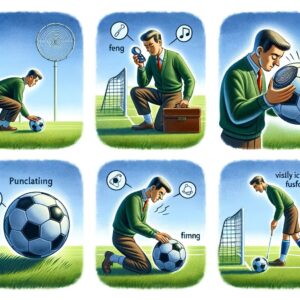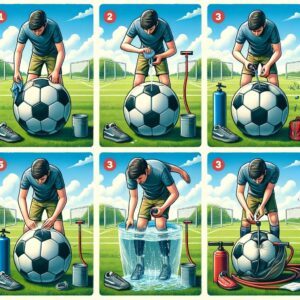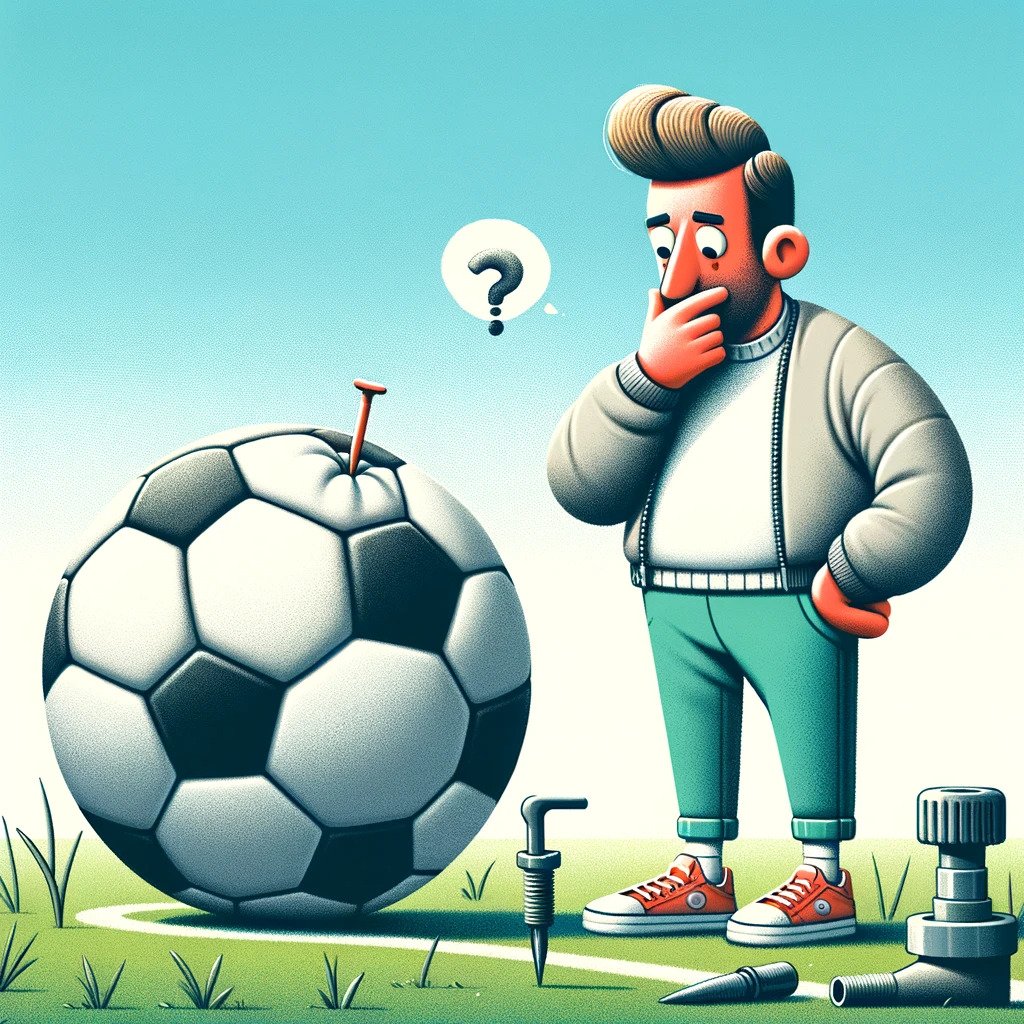As an avid soccer enthusiast, I’ve often encountered the frustrating situation of finding Why does my soccer ball deflated. Whether it’s just before a crucial game or during a casual play, this issue seems to have become more common than one would expect. The perplexity of this problem is amplified when you realize that the ball in question is your only one, leaving you in a real predicament.
So, if you’ve ever wanted to explore why this happens and want to learn more about preventive measures, you’re not alone. Reading up on these topics has become a part of my routine, ensuring that my soccer game remains uninterrupted.
Common causes of why my Soccer Ball keeps Deflating
As we cut to the chase on our page, let’s learn about the reasons your soccer ball might deflate. The most frequent culprit is damage – whether your ball is punctured or just worn out. Sometimes, the air leaks out after the ball is kicked against a sharp object. This is often a subtle issue, and you might only realize it when you squeeze the ball and hear a hissing sound indicating a puncture.
Damage to the Ball’s Exterior
If there’s visible damage, it’s crucial to either repair or replace the ball as soon as possible to prevent further issues. Even minor scuffs can lead to bigger problems over time.
Leaky Valve in a Soccer Ball
Another issue can be a leaky valve – that small opening where you insert the pump. If this valve is damaged or not screwed in tightly, air can escape. It’s wise to check this regularly and ensure it’s in good condition and securely fastened.
Underinflation of a Soccer Ball
Underinflation is another factor. A ball that’s too soft affects both its bounce and overall performance on the field. It’s easy to spot a ball that needs more air – it makes a thud sound when bounced. Remember, the rule of thumb is to keep it inflated between 8.5 – 15.6 PSI.
Overinflation of a Soccer Ball
Conversely, overinflation can cause the ball to deflate quickly. If too much air is pumped in, it seeks to escape through the seams. Always check the recommended inflation pressure and use a gauge to ensure you’re not exceeding it. Overinflation can also cause the ball to become misshapen, impacting its performance.
As an experienced player, I’ve learned to trust my gut on this. If the ball feels hard to the touch, it might be time to squeeze some air out.
How to Detect a Deflated Ball?

Detecting a deflated soccer ball starts with a simple visual inspection. As a player, I’ve learned that a quick look can tell you a lot. Inspect the ball to see if it appears fully inflated. A healthy ball should be round and firm, with no visible deformities. If it seems misshapen or has a flattened appearance, it’s a clear sign of deflation.
Visually Inspect
The position of the valve is another key indicator. If the valve is pushed in or sunken, it’s an indication that the ball isn’t fully inflated. On the flip side, if the valve is sticking out too far, your ball might be overinflated.
Physical Inspection
When you suspect your ball isn’t fully inflated, it’s time for a physical inspection. Press down on the ball with your hands. It should feel firm to the touch and have just a little give.
Another technique is dropping the ball from a height of about three feet. A well-inflated ball should bounce back up almost to the same height. If it doesn’t, it probably needs more air.
Kicking Test
The true test comes with kicking. A fully inflated ball should be easy to kick and travel a good distance. A deflated ball, however, won’t travel as far and will make a noticeable noise.
Trust Your Instincts
Over time, as you play more, you’ll naturally know if a ball is deflated, over-inflated, or just right. It’s about feeling and looking at the ball – a skill developed with experience.
Soccer Ball Pressure PSI
Understanding the pressure PSI of a soccer ball is crucial in addressing deflation issues. As the governing body of football/soccer, FIFA plays a pivotal role. This organization lays down the laws for international competitions, including everything from league football to grand events like the World Cup. FIFA clearly states that a soccer ball must not only be spherical (round) but also inflated to the proper PSI.
In the world of soccer, the correct ball pressure falls anywhere between 8.5 PSI and 15.6 PSI. While different leagues or competitions may inflate their balls to various levels of PSI, there’s a general rule to keep it around the same range. This standardization ensures consistency in play and, in my experience, helps in maintaining the ball’s condition over longer periods.
Does Deflating a Soccer Ball Make a Difference?
Deflating a soccer ball on purpose can make a big difference. When a ball is pumped up too much, reaching its max, it becomes harder and sometimes even painful to kick. The high pressure inside the ball not only makes it fragile to the point it could pop, but it also affects how well you can move the ball on the pitch. Finding that medium point between a fully pumped-up ball and an almost flat one is crucial.
In contrast, deflating a ball doesn’t change anything if the ball has a bad shape or is losing air due to a puncture, as mentioned above. If the ball’s shape is so wrong that it looks more like an egg than a round ball, it’s a sign you should replace it. This issue is commonly found with cheaper balls that aren’t made of the best materials. In terms of losing air, purposely deflating it a little or a lot won’t stop air from coming out, especially in the case of a puncture.
How to Fix a Deflated Soccer Ball?

If you’re faced with a deflated soccer ball, don’t worry. You can easily fix it with a few simple steps. Whether you’re getting ready for a game or just keeping your equipment in playing shape, these methods are here to the rescue.
Replacing the Valve
Sometimes, the issue lies with the valve, a small plastic piece that controls the air being pumped in and out of the ball. If it’s loose or damaged, it’s likely causing the ball to deflate. Here’s how to tackle it:
- Locate the valve on your soccer ball.
- Use a screwdriver to gently twist the valve counterclockwise and remove it.
- Insert a new valve into the hole and twist it clockwise to secure it in place.
- Pump the ball with air and test to make sure it’s holding air properly.
Using a Repair Kit
If the valve isn’t your problem, a repair kit might be the answer. To use it:
- Deflate the soccer ball completely.
- Apply a small amount of glue or sealant to the valve and let it dry for a few minutes.
- Again, pump the ball and test its air retention.
- Be sure to follow the kit’s instructions carefully to avoid damaging the ball further.
A Practical Perspective
Honestly, sometimes it’s too much trouble to repair a permanently deflated ball. If you’re a regular soccer player, you likely have access to many balls, whether at your local school or soccer club. And who knows, maybe you’ll find a few more in the woods!
How Long Do Soccer Balls Last?
The lifespan of a soccer ball is closely tied to its user and how it is used. When used properly, like on grass, a soccer ball can last a good 2-3 years. This durability is a key factor for players who aim to improve their skills with a high-quality ball, which is paramount in the world of soccer. Proper use ensures the ball retains its condition and functionality, making it a reliable part of your sporting gear.
However, if you use it incorrectly, such as kicking it on bitumen, you risk causing scruff marks and possibly creating a hole in the ball. Such rough handling can drastically shorten its life, meaning it might not even last a single year.
To extend the life of your soccer ball, take care of it. Do not neglect it, leave it outside in the rain, or forget to clean it. Simple maintenance steps can make a significant difference in how long your soccer ball lasts, keeping it in top condition for your games and practice sessions.
Does the Weather Impact Soccer Balls?
The mystery of a soccer ball losing air isn’t always about a puncture or the ball deflating naturally. A significant factor often overlooked is the temperature. Scientific research backs the theory that changes in temperature — an increase in the summer or a decrease in the winter — can significantly affect the air inside the ball. This is due to the energy of the molecules changing in reaction to the temperature, which in turn affects how quickly a ball deflates.
When the weather is warm, the molecules move faster, as opposed to when it’s cold, where they move less. This difference in molecular movement means that in colder weather, the air in the ball can dispense quicker, leading to more frequent deflation. However, this effect, while scientifically valid, isn’t something that should cause too much worry. It’s a natural occurrence beyond our control.
For soccer enthusiasts, it’s important to know that while you can’t control the weather, maintaining your soccer ball is still within your grasp. Keeping a football pump in your house allows you to easily refill the air if your ball does go down quicker than expected. This simple tool ensures your ball is always ready for action, no matter the weather conditions.
Preventing Your Balls from Being Deflated
Proper Inflation is key to prevent your soccer ball from deflating. Always inflate the ball to the correct pressure as overinflating can cause the ball to burst, while underinflation can make it lose its shape and bounce improperly. The recommended pressure range is typically printed on the ball or detailed in the manufacturer’s instructions. Using a pressure gauge to ensure the ball is inflated correctly is a simple yet effective step.
Storage Considerations
How you store your soccer ball significantly affects its air capacity. When not using your ball, proper storage is crucial. Deflate the ball when storing it for an extended period, such as the off-season, to relieve pressure and prevent it from losing air. Conversely, while actively playing, store it in a cool, dry place, away from direct sunlight and extreme temperatures. Bringing your soccer ball inside every day adds more years to its life.
Maintenance & Care for Longevity
Proper care of your soccer ball not only helps prevent deflation but also ensures a longer life. Avoid kicking the ball on hard surfaces like concrete or asphalt, which can damage the ball’s surface and valve. Wipe the ball regularly with a damp cloth and mild soap, steering clear of harsh chemicals or abrasive cleaners. This routine upkeep will maintain the ball’s condition and performance.
How Do You Keep a Soccer Ball in Good Condition?
To maintain your soccer ball in top condition, consider the following points:
- Deflate the ball when storing it away to avoid putting unnecessary pressure on its structure.
- Pay close attention to the valve during inflation; it’s crucial for maintaining the ball’s integrity.
- Always inflate the ball to the proper psi for the game you’re playing, as this affects performance and longevity.
- Clean the ball properly after each use, using gentle methods to preserve its material and appearance.
- Play on suitable surfaces, such as grass, and avoid abrasive surfaces like bitumen to prevent damage.
- Avoid using chemicals or detergents for cleaning; these can harm the ball’s material.
- Do not stand or sit on the ball, as this can deform it and impact its playing qualities.
Can You Wash a Soccer Ball?
Yes, cleaning your soccer ball is not only possible but also recommended to maintain its condition. Start by rinsing the ball to remove any loose dirt. It’s important to use a rag for this process and to ensure you do not drench the ball, as too much water can cause the seams to deteriorate. Once the initial dirt is gone, prepare a diluted spray solution – typically 50% soap and 50% water, although other ratios can work too.
After applying the spray, leave it on the ball for about 30 seconds. Then, scrub gently over each section of the ball. It’s crucial to be gentle to avoid damage. Next, rinse the ball with a wet cloth, ensuring that all soap is removed. Finally, use a towel to dry the ball properly. Once it’s dry, your soccer ball is good to go for your next game or practice session.
Conclusion
Maintaining your soccer ball’s integrity is essential for a consistent and enjoyable playing experience. Regularly checking for and addressing deflation issues, proper storage, and careful cleaning can greatly extend the life of your ball.
Understanding the factors that lead to deflation, whether it be from improper inflation, environmental conditions, or general wear and tear, allows you to take proactive steps in preserving your soccer ball. With these tips and insights, your soccer ball should remain a reliable and high-performing part of your sporting gear for many games to come.
Frequently Asked Questions
Do soccer balls deflate in the cold?
Yes, soccer balls can deflate in cold temperatures. Cold weather causes the air inside the ball to contract, leading to reduced pressure and deflation.
How much PSI should a soccer ball have?
A soccer ball should typically have a PSI (pounds per square inch) between 8.5 to 15.6. The exact PSI can vary based on the ball’s size and the manufacturer’s recommendations.
My football is leaking air. How do I stop it?
To stop a football from leaking air, first identify the source of the leak. If it’s a valve issue, you may need to replace or tighten the valve. For punctures, a repair kit can be used to seal the leak.
How do you keep soccer balls inflated?
To keep soccer balls inflated, regularly check and adjust the air pressure to the recommended PSI. Store the ball in a cool, dry place, and avoid overinflation which can stress the ball’s structure.
What to do with a deflated soccer ball?
If you have a deflated soccer ball, first try to reinflate it to the correct pressure using a ball pump. If it doesn’t hold air, check for punctures or valve damage, and use appropriate repair methods or replace the valve if necessary.

